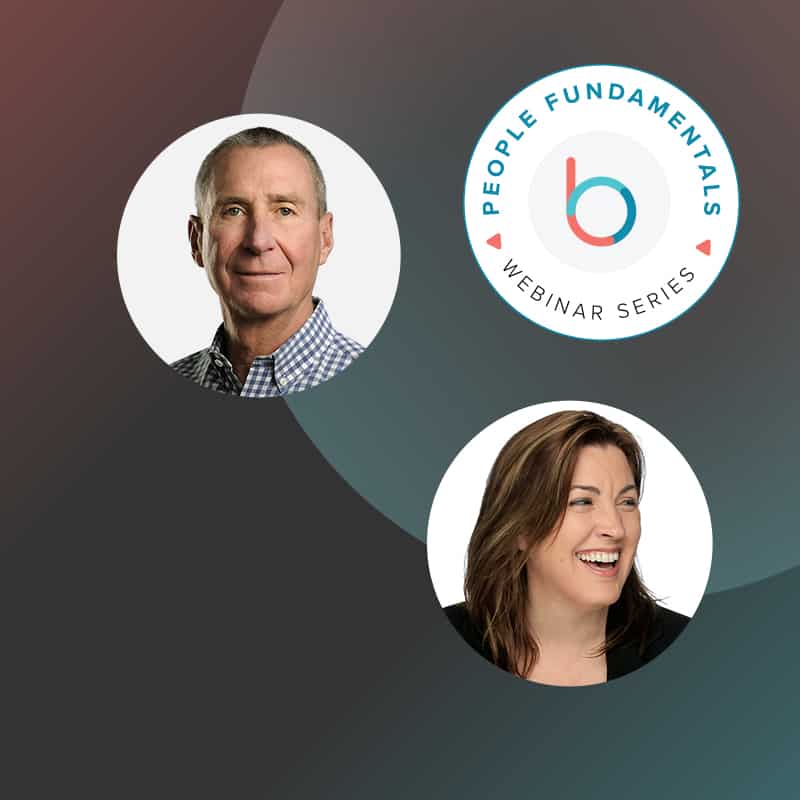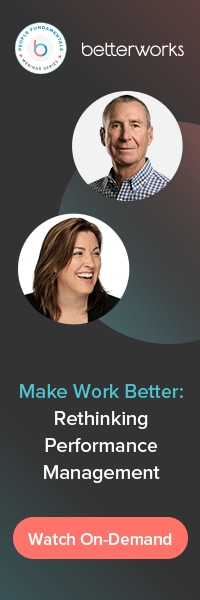The idea of performance management is more than a century old — and those old ways of thinking about performance no longer make sense for today’s workplaces.
The annual review, in particular, is a going-through-the-motions exercise that doesn’t improve employee outcomes. “People hate getting it, people hate giving it — and it doesn’t change performance,” says Doug Dennerline, Betterworks CEO and co-author of the upcoming book “Make Work Better” in a recent session of our People Fundamentals webinar series. Dennerline and his “Make Work Better” co-author, Betterworks Vice President of HR Transformation Jamie Aitken, discussed how they’re updating performance management for the modern world.
Check out the highlights from Dennerline and Aitken’s conversation about rethinking performance management.
From valueless to value-add
Legacy performance management processes haven’t been functional for a long time. But executives “don’t actually experience how terrible it is for everybody else because they’re not doing it themselves,” Dennerline says. That blindspot keeps leaders from recognizing how little value traditional performance management adds.
Fortunately, some leaders recognize that rethinking performance management processes can help managers and their reports drive business value. This revelation is the result of several circumstances converging in recent years, including the Great Resignation, five generations in the workforce, the pace of innovation, and COVID-19.
“What fundamentally shifted … was that HR was getting more and more at the center of what was challenging for the business,” Aitken says. That’s created a shift toward enabling performance rather than simply “managing” it.
“A very high percentage of people in the HR space actually understand that their processes are ineffective and more compliance-driven,” Dennerline says. These HR professionals don’t always know how to reimagine such a heavy process in a lightweight, achievable way.

Support in the flow of work
Rethinking performance management starts with more frequent conversations. Instead of just annual or semiannual performance reviews, managers and employees have frequent check-ins and dialog within the flow of work. Workers can correct behaviors in real-time while staying focused on their goals and the team’s.
“We like to base our employee conversations around goal attainment and the check-ins around how you’re doing against those goals,” Dennerline says.
This model moves the focus from arbitrary, forced rankings to helping each person see their role in achieving business goals. “If you change the conversations that you have between managers and employees around setting quarterly goals, it changes the conversation to something that is not so much about a rating,” Dennerline says.
Consider this scenario: A manager and employee are having frequent check-ins and aligning on a quarterly or biannual basis. They talk about such topics as the employee’s assignments, how the manager can remove roadblocks and empower success, and options for learning and development.
“That employee is feeling engaged because they know that they’ve got the support that they need to focus on and achieve the things that they’re trying to achieve,” Aitken says. “That’s a whole lot different of an environment and experience than what a traditional performance management process delivers.”
Modern performance management is fundamentally about good communication. Everyone wants to be heard and to have productive conversations in their personal lives. “What we’re suggesting here is that we don’t stop being human when we show up at work, and that the same need for more feedback is consistent,” Aitken says.
Less work, more often
While HR teams recognize that the system has to change, many HR leaders hesitate because continuous performance management feels like asking people to do more work.
While having regular check-ins means meeting more often, this process doesn’t burden managers. “More frequent, lighter-weight conversations actually take much less time and are much more impactful,” Aitken says. Frequent check-ins are easier to plan for — and more productive — than evaluating a year’s worth of performance data. “We’re removing the burden and adding value,” she says.
That said, managers need support if they’re to carry out these conversations the right way, record the performance data, and track it against goals. Start by communicating why you’re shifting to a performance enablement model and what that means for managers. When you have their buy-in, you have a better chance of success. And as the program is rolled out, HR should regularly check in with managers to see what they need in terms of support.

Communicating well about strategic performance enablement is important for maintaining leadership support, too, Aitken says. “Beyond improving the culture and engagement, HR needs to be able to articulate how what we’re doing in this transformation is also going to affect the business.”
Rethinking performance management brings frequent conversations to the forefront. HR gains visibility into the real-time state of the workforce. Managers get to know their reports better and how they can support them. Your workforce understands what they’re supposed to focus on and how their efforts support the business. Make work better by ditching the old ways of performance management and empowering your workforce to reach its full potential.
Make Work Better: Rethinking Performance Management








